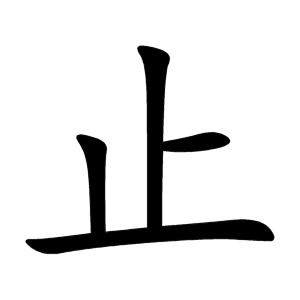止
- to stop, to cease, to halt;
Etymology
Originally, 止 is a pictograph representing the shape of a human sole of the foot, thus it originally meant “foot.” However, later it was borrowed (used phonetically) to mean “to stop” or “to cease.” To represent the original meaning “foot” more explicitly, a separate character 足 (foot) was created, and with it, 趾 (toe).
Usage in Korean
When 止 is used as a component in other characters such as 從 (follow) or 步 (step), it often carries meanings related to “going” or “walking.” It shares its etymological root with 之 (to go), and in cursive script (草書), 止 was often written flowing into a shape similar to 之. This usage continues to appear occasionally even in modern times.
The character 足 also has cursive forms, such as 𠯣 (⿱口之), found in ancient documents. The character 乏 (lack, insufficient) is actually a typeface that originated from such cursive forms.
Structurally, 之 (to go) is derived by adding one stroke to 止 (foot), but etymologically, it is the reverse: 止 (foot, the action of going) is derived from 之 (to go, flat tone).
Representative characters with this radical include 正 (correct), 步 (step), 武 (martial), 歲 (year), and 歷 (to pass).
Characters containing the 止 radical generally indicate meanings related to feet, legs, walking, or leg movements. It also serves as a fundamental component in the lower parts of other radicals or characters such as 足 (foot), 疋 (bolt of cloth), 走 (run), and 辵 (walk/move).
Alternative forms
Characters with 止
Words that derived from 止
- 卜中一 (YLM)
- ⿱⿰ 丨 ⺊ 一
- ⿻ 上 丨
- ⿺ ⺊ 丄
